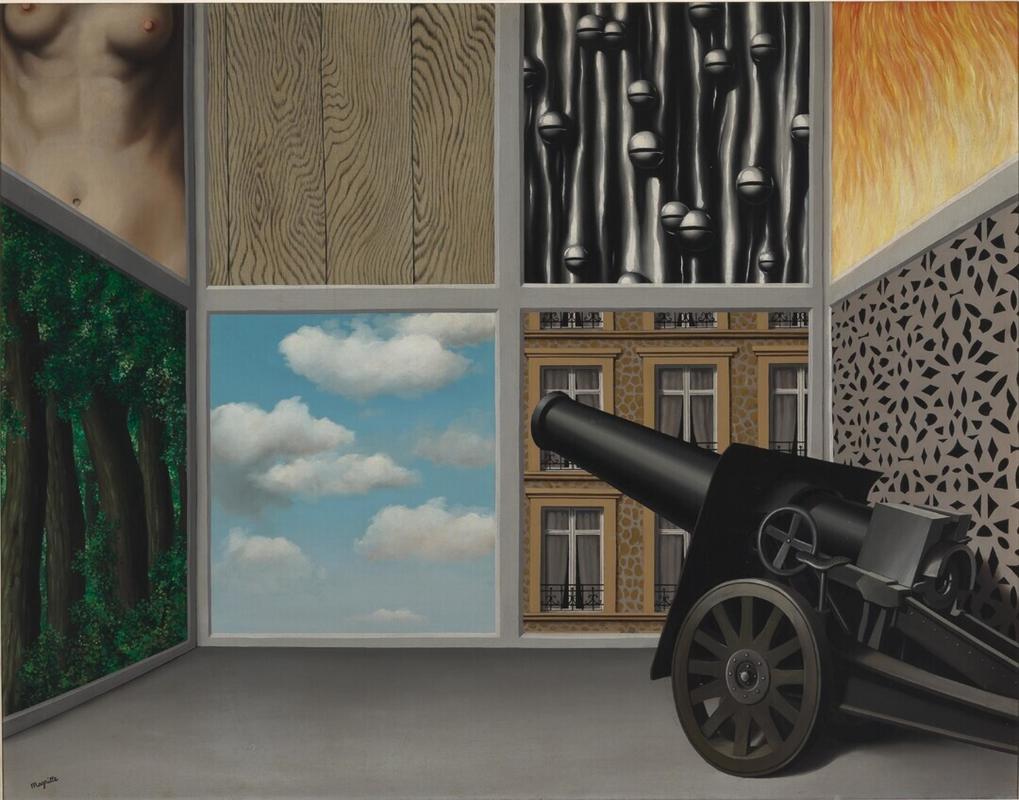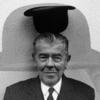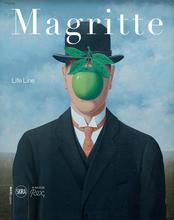More about On the Threshold of Liberty
- All
- Info
- Shop

Contributor
Andy Warhol enjoyed the collapse of barriers between business and art, and in this regard he was directly influenced by the craftiness of Magritte in finding commissions, as evidenced by the strange Au seuil de la liberté.
Magritte's Picasso-esque shrewdness showed itself in the production of the painting, for his patron Edward James, the only heir of William James. In February 1937, Magritte went to stay with James at Wimpole in Marylebone, London, in order to deliver three large surreal pieces for the ballroom of the neoclassical residence, including a vertical version of Au seuil de la liberté. After these were done, James ordered three more paintings for the ballroom, and two portraits without faces, including one of the back of the patron's head, and another which replaces his head with a luminous glow. Magritte obtained this rapid-fire series of commissions by being blunt and direct about his aims, knowing that Dalí had already obtained the support of James. After he finished the eight commissions, he doubled down, informing James of a funny coincidence: "you have too much" money, Magritte wrote, and you should give some of it to me, who has too little. In the rest of his letter he arranged a monthly contract to supply James with art.
Comparing the process of visual arrangement in Au seuil de la liberté with earlier paintings in the Magritte oeuvre, David Sylvester writes that the artist "made the number of panels up to eight with one representing wooden boarding. But, instead of showing the polyptych standing in a room, he made it the walls of a room, and stuck a cannon on the vacant floor."
With his dry wit, the great John Berger found that Au seuil de la liberté had managed to, in a very 1968 way, grasp the impossible "as an absence in a statement made in a language originally and specially developed for depicting particular events in particular settings." Berger calls the impossible a "moral concept," which attends to the honor of unseen forces both unsensed and unheard. Rather than the mere sensation of the impossible, as in the absurdism of Claes Oldenburg installations or Magritte's apple that fills a room, Au seuil de la liberté achieves a higher level of abstraction.
It is important to recognize that this is one of many Magrittes which represents violence toward women, particularly the female torso, as noted by the writer Lisa Lipinski, which is both straight from the unconscious and quite difficult to accept. Magritte was overcome with shame, in constant contact with his wife who had caught him in an affair the year earlier. Magritte also had unresolved childhood trauma regarding his mother. As Lipinski reminds us, Magritte would have not have wanted writers to psychoanalyze him and read his paintings symbolically, as the strangeness of the work should speak for itself...but the cannon at the woman's torso is not a good look, which was probably the whole point. One of the main goals of the Surrealist clique is to regurgitate the symbols and horrors of war, a bit like Francisco Goya, in order to wake people up. Does it work?
Sources
- Allmer, Patricia. "Framing the Real." In Borders in Literature and Other Media, edited by Walter Bernhart and Werner Wolf (New York: Rodopi, 2006): 113-38.
- Berger, John. About Looking. New York: Knopf Doubleday, 2011.
- Darras, Bernard. "Sémiotique du système des objets dans la poétique de Magritte. La durée poignardée entre aisthésis et semiosis." Recherches sémiotiques 28 (3-1, 2008-09): 81-108.
- Lipinski, Lisa. René Magritte and the Art of Thinking. New York: Routledge, 2019.
- The Remaining Contents of the Studio of René Magritte: The Property of the Late Georgette Berger, the Widow of René Magritte. New York: Sotheby's, 1987.
- Sylvester, David. Magritte. Paris: Flammarion, 1992.
- Sylvester, David. Magritte: The Silence of the World. London: Praeger, 1992.












